This article was published in Scientific American’s former blog network and reflects the views of the author, not necessarily those of Scientific American
Regular readers will recall that pigeons and doves (collectively, the columbiforms) have been covered on a few previous occasions here at Tet Zoo (see links below). But these birds are so accessible and easily photographed – and neat and interesting to boot – that, sorry, I simply have to cover them again. In this and a few subsequent articles I want to write about some of the pigeon species we have here in the UK. And many of you outside of the UK will be pretty familiar with these species too – none of them are exclusively British.
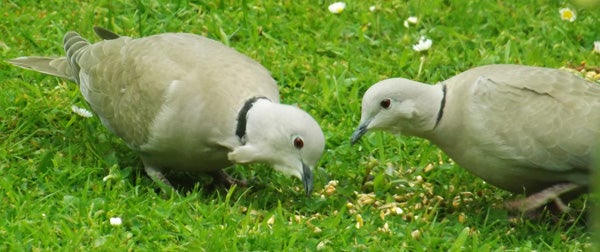
A fine pair of pigeons, feeding on the lawn of a suburban garden in England. Credit: Darren Naish
We start with the Collared dove Streptopelia decaocto… and this is an odd choice, because this bird that isn’t, technically, a native at all – it’s a recent invader of southern Asian ancestry, and it has staged a highly successful trans-European invasion since about 1930. This invasion perhaps started in the Balkans, a region where the species might have been introduced (perhaps from India?) during the time of the Ottoman Empire. It reached the UK – and bred here – in 1955, and it spread across Scandinavia, the Iberian Peninsula and the Scottish islands during the 1960s and 70s. This event has been discussed and illustrated several times in the popular literature on birds. Here it is as illustrated by Roger Tory Peterson in his 1964 book with James Fisher, World of Birds (Fisher & Peterson 1964)…
On supporting science journalism
If you're enjoying this article, consider supporting our award-winning journalism by subscribing. By purchasing a subscription you are helping to ensure the future of impactful stories about the discoveries and ideas shaping our world today.
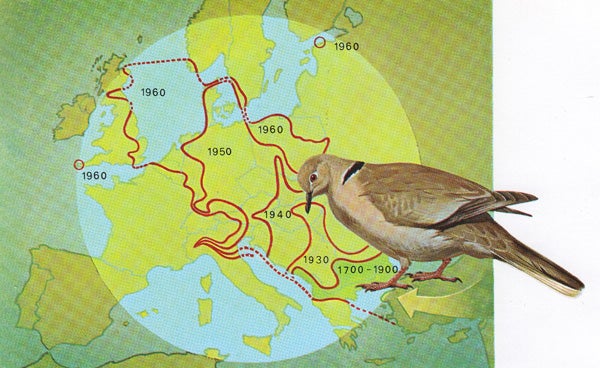
A (now very dated) map showing the spread of the Collared dove across Europe, from Fisher & Peterson (1964). Credit: Fisher & Peterson 1964
The idea that the distribution of the Collared dove in China, Japan and Korea is also due to the deliberate release of Indian birds is out there too (Goodwin 1967). But – as far as I can tell – nobody has really worked any of this out, making it essentially impossible (for now) to say what of this bird’s distribution is ‘natural’ and what is ‘unnatural’. UPDATE: yes, I know that this species is in North America too. I’ve opted not to cover its spread across North America for now...

Collared dove male (at left) and female in a suburban garden in southern England. This male has something wrong with his crop and always looks like this. Note also that the female's collar is not visible here due to the angle, and the pose she's in. Credit: Darren Naish
A huge amount of speculation has surrounded the cause for its spread across Europe, popular suggestions including the evolution of a newer, roving phenotype, a switch in nesting behaviour (from building-associated nesting to tree-nesting), reduced predation from whatever it was that predated on it beforehand (Roselaar 1985), or the exploitation of grain transported in trucks and/or trains. Maybe all of these came into play – the species has been described by some authors as being virtually parasitic on humans and wholly dependent on them in many areas (Goodwin 1967).
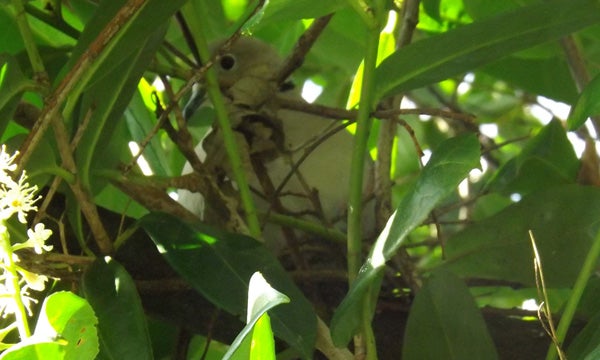
Nesting Collared dove in laurel, photographed in southern England in late February 2016. As is typical for many Old World pigeons, note that the nest is a sparse, flimsy platform of thin sticks. Credit: Darren Naish
Whatever, it’s widespread in the Palaearctic, occurring south to regions of Egypt, Oman, Sri Lanka, and east to Japan. It isn’t present continuously across this region, there being some major gaps (a big one separating the European population from that of Central Asia), and its distribution across the Arabian Peninsula is decidedly spotty. The Collared doves across this huge area aren’t all the same, and are supposed to represent five or so subspecies. Some of the differences concerned seem clinal though: birds in the east and south of Asia are smaller and darker than those in Europe and close to it.
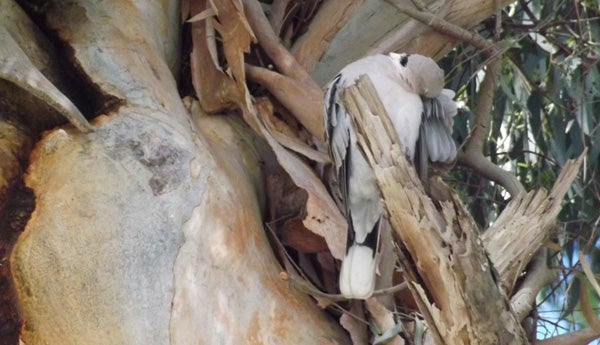
Preening Collared dove in a eucalypt, photographed on Gran Canaria. Credit: Darren Naish
The Collared dove is pale, and in fact one of the palest pigeons in the region. Males and females can just about be distinguished if you know what to look for: males are slightly larger and have (apparently) a slightly pinkish face, though this is too subtle for my crappy colour vision. Males perform a distinctive display flight which involves steep ascent from a perch, a few over-emphasised, clappy wing-beats, and a spiralling flight with spread wings and tail. Despite seeing this on a regular basis (at least, say, once in a week in the area where I live), I’ve never been able to photograph it, most typically because I don’t have my camera with me at the time. Wing-clapping as an alarm signal is common and vigorous fights – mostly (but not entirely) between males – are common too; they involve wing-beating, feather-pulling, striking with the bill, and even jumping onto the opponent’s back.
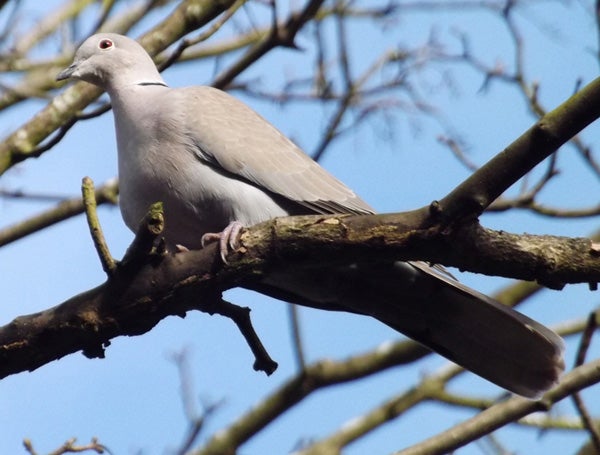
Collared dove profile, photographed on my local patch in Southampton, UK. Credit: Darren Naish
The black collar that these birds are named for is often fringed with white, though I didn’t notice this until I saw it in Libyan birds and first thought it was a local difference. It isn’t, it’s pretty much ubiquitous. One interesting thing – well, interesting if you’re interested in this sort of thing – is that the collar is sometimes virtually concealed when the birds have their neck partially retracted or inflated when calling.

Pigeons of distinct (but closely related) lineages in close proximity. Collared dove in the foreground, Common wood pigeon Columba palumbas in the background. Credit: Darren Naish
Where does the Collared dove fit within the pigeon family tree? Molecular phylogenies find Streptopelia to belong in a pigeon clade that also includes Columba (Old World pigeons), Macropygia (cuckoo-doves), Geotrygon (quail-doves), Zenaida (zenaida doves) and Leptotila (Caribbean dove and kin) (Johnson & Clayton 2000, Johnson et al. 2001, Shapiro et al. 2002). Incidentally, Ectopistes – that’s the Passenger pigeon – is a member of this clade too (Shapiro et al. 2002). Within Streptopelia, the Collared dove is especially close to the African collared dove S. roseogrisea and the Mourning collared dove S. decipiens (Johnson et al. 2001). This group of species are, in turn, close to the turtle doves but not to the group that includes the laughing doves and kin: the latter birds were conventionally included within Streptopelia but are now generally referred to as Spilopelia or Stigmatopelia. Streptopelia of tradition is, you see, far from monophyletic (Johnson et al. 2001). On that note, we move on.
For previous Tet Zoo articles on pigeons and doves, see...
Refs - -
Fisher, J. & Peterson, R. T. 1964. World of Birds. Macdonald & Co, London.
Goodwin, D. 1967. Pigeons and Doves of the World. British Museum (Natural History), London.
Johnson, K. P., S. De Kort, K. Dinwoodey, A. C. Mateman, C. Ten Cate, C. M. Lessells & Clayton, D. H. 2001. A molecular phylogeny of the dove genera Streptopelia and Columba. Auk 118, 874-887.
Johnson, K. P. & Clayton, D. H. 2000. Nuclear and mitochondrial genes contain similar phylogenetic signal for pigeons and doves (Aves: Columbiformes). Molecular Phylogenetics and Evolution 14, 141-151.
Shapiro, B., Sibthorpe, D., Rambaut, A., Austin, J., Wragg, G. M., Bininda-Emonds, O. R. P., Lee, P. L. M. & Cooper, A. 2002. Flight of the dodo. Science 295, 1683.